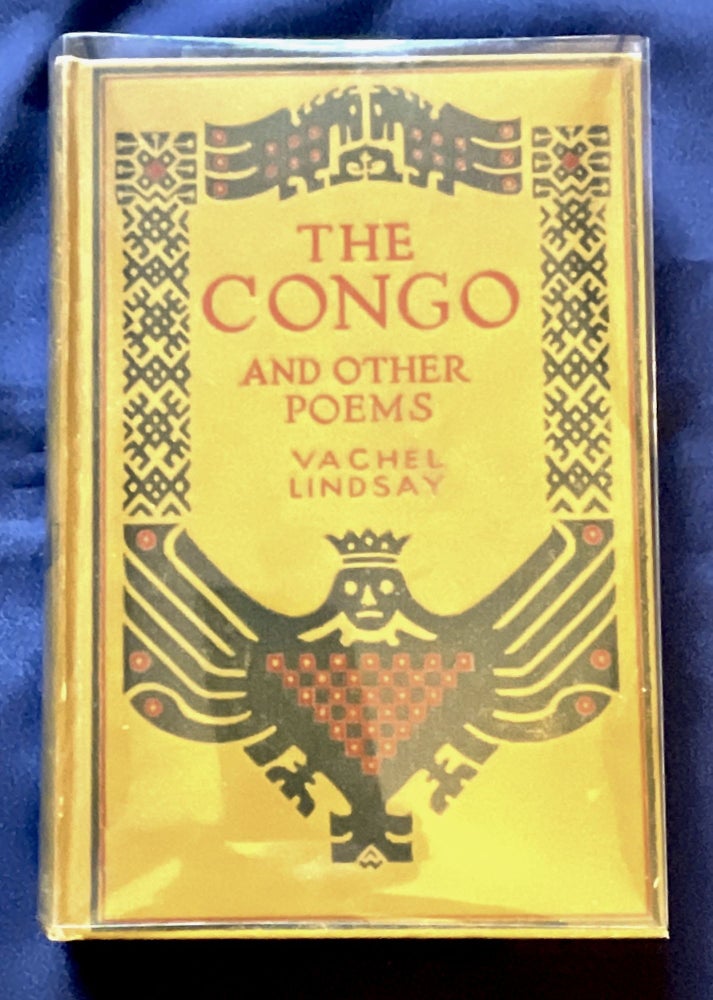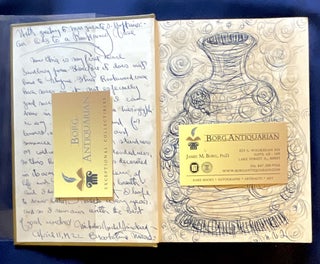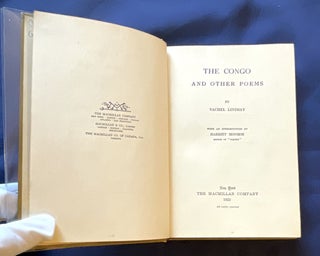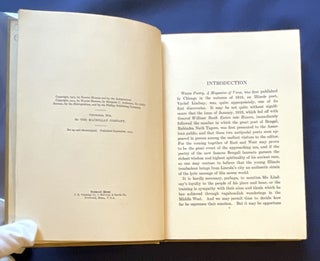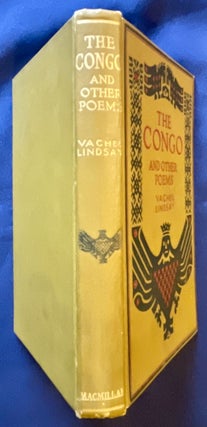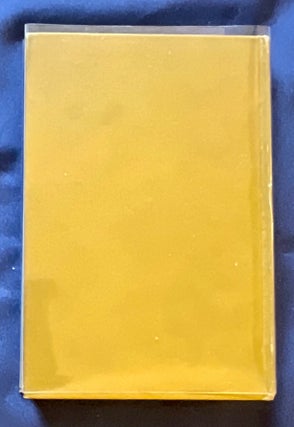THE CONGO; And Other Poems By Vachel Lindsay / With an Introduction by Harriet Monroe
New York: The Macmillan Company, 1922. Vachel Lindsay. Reprint of the First 1914 Edition by Macmillan. Pictorial cloth. INSCRIBED / SIGNED & DATED with an ORIGINAL POEM, "AN ODE TO A ROOKWOOD VASE" & ILLUSTRATION (possibly unpublished) by the poet-artist Vachel Lindsay; small 8vo (7 5/8" x 5 1/4"); brown pictorial cloth with gold lettering & Art Deco heraldic "Thunderbird" design on spine + elaborately decorated front cover with facing "dragons" at top - framing deco borders - below: "Thunderbird" red-&-black escutcheon; Introduction by Harriet Monroe; xv, [xvi] + 159 pages. Near Fine. Item #9031
Nicholas Vachel Lindsay (1879 – 1931) was an American poet some called the "Prairie Troubador." He is considered a founder of modern "singing poetry", in which verses were meant to be sung or chanted--sometimes with musical accompanyment. He strove to revive poetry within its oral tradition and as a way to bring Midwestern and other communities together. Lindsay hoped to be seen as a “bard, ballad singer, troubadour.”
The poet's fame grew during the 1910-20's--the War Years and Jazz Age--after Harriet Monroe, prominent editor of "Poetry" magazine, praised and published him with two other Illinois poets--Carl Sandburg and Edgar Lee Masters. Years later to memorialize his deceased fellow-poet, Masters' would write a eulogizing biography entitled, Vachel Lindsay: A Poet in America (1935).
As a travelling bard, Lindsay often engaged in dramatic recitals. Among his most popular poems were "The Santa Fe Trail,” "General William Booth [of the Salvation Army] Enters into Heaven," "Johnny Appleseed," the "Booker Washington Trilogy," and “Abraham Lincoln Walks at Midnight."
"The Congo" became a highly popular best-seller. Like other poems, it has been set to music. Lindsay's poems have inspired such composers as Charles Ives and Sidney Homer to Norman Dello Joio and Jake Heggie.
"He composed his most famous poem 'The Congo' while he traveled on foot from Illinois to New Mexico, exemplified his revolutionary aesthetic of sound for sound's sake. The poem was inspired by a sermon preached in October 1913 that detailed the drowning of a missionary in the Congo River. It imitates the pounding of the drums in the rhythms and in onomatopoeic nonsense words. At parts, the poem ceases to use conventional words when representing the chants of Congo's indigenous people, relying just on sound alone."--Best Poems Encyclopedia
According to The Poetry Foundation:
"One of Lindsay’s most famous poems, the title piece has a rhythmic structure based on African-American speech rhythms and jazz. He recited the poem in a variety of voices ranging from a loud, deep bass to a whisper. A Springfield Republican reviewer saw the publication of “The Congo” and Other Poems as the single most interesting event in the American literary scene. “All in all there is an intense and vivid Americanism in these poems—a racy, pungent, authentic note, which, if he fulfills the last measure of his [artistic] promise, will make Mr. Lindsay a prophet of American life,” the reviewer explained.
Black writers and intellectuals of the period were less sanguine about Lindsay’s attempts at prophecy. W.E.B. DuBois, remarking on Lindsay’s work in Poetry magazine, declared “Mr. Vachel Lindsay knows two things, and two things only, about Negroes: The beautiful rhythm of their music and the ugly side of their drunkards and outcasts. From this poverty of material he tries now and then to make a contribution to Negro literature. It goes without saying that he only partly succeeds.”
Against aspersions of racial insensitivity, one rebuts that Lindsay--the son of a Union surgeon and profound admirer of President Lincoln--was appalled by lynchings of blacks in Springfield, Illinois, and spoke out against such racist brutality in "The City That Will Not Repent." Deeply troubled, he also delivered "Ten Lectures" on ethnicity at the local Y.M.C.A. Note, too, that Langston Hughes was influenced by Lindsay's poetry, which trumpeted Emersonian and Whitmanesque patriotic values, a "Gospel of Beauty," and the romantic love of nature.
In addition to several volumes of poetry, Lindsay also published the first American study of film, The Art of the Moving Picture (1915), works of memoir including A Handy Guide for Beggars (1916), and the utopian fiction, The Golden Book of Springfield (1920).
His broad interests also included artwork and sketching for which he had had formal training at the Chicago Art Institute (1900-1903) and New York School of Art (1904). As a result, he loved to impressionistically and often whimsically illustrate some of his poems.
Lindsay's inscribed and original composition, "An Ode to a Rookwood Vase," and his accompanying sketch of a decorative Rookwood vase with roses (perhaps based on an original vase of his admirer?) represent a significant expression of his talents.
No poet could write such a title and poem without being aware of the background association of Keats' famous "Ode on a Grecian Urn," which also alludies poetically to a fine ceramic with decorations.
Lindsay, however, downplays the importance of his improvisation by first registering--by way of disclaimer--that "Now this is my first Carl Sandburg poem. Therefore it does not have to rhyme." That's as if to say: "Ah, shucks, this is just a plain, folksy, free-verse, impromptu though lovingly handcrafted work."
We have not found it listed among VL's many published poems--though it may be--however because this volume has been in private hands for many years does suggest lack of prior publication.
Tight bright volume with Art Deco cover designs. Poem on front pastedown; sketch facing on front free endpaper. Light soil and a traces of edgewear to cloth. Very Light uniform toning to paper. Clean internally apart from five tiny pen tick marks [possibly by VL of Mrs. Hopkins] opposite titles of poems listed in the Table of Contents [at xi, xiv]; plus the entries [by VN??]: "Read here / Ap{ril} 10 - 1922" [p.3: above the printed "The Congo"]; "Read Ap13 1922" [p.65: in pencil above "The Leaden Eyed" & at p. xi]; no annotation above "What the Moon Saw" [p.133, though it had been ticked p.xiv]; an ink tick above "A Curse For Kings," p.148; cf.p.xiv}. No other marks apart from Lindsay's own handwritten, signed, and dated poem and artwork--both in ink. Protective clear polyester dust jacket added.
Price: $995.00

